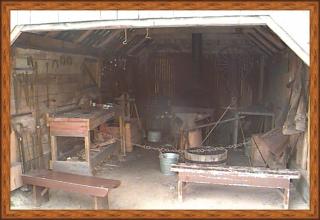
 As you can see the blacksmith shop is
very small and crowded, which leaves the blacksmith with very little room for
error. During the late 1920s-early 1930s, the role of the blacksmith changed.
Mass production meant that handmade work was not needed as much any more. In order to stay
in business the blacksmith turned to repair for most of his work. It was during this
time that horseshoeing became associated with the blacksmith trade.
As you can see the blacksmith shop is
very small and crowded, which leaves the blacksmith with very little room for
error. During the late 1920s-early 1930s, the role of the blacksmith changed.
Mass production meant that handmade work was not needed as much any more. In order to stay
in business the blacksmith turned to repair for most of his work. It was during this
time that horseshoeing became associated with the blacksmith trade.
In addition to shoeing horses, the blacksmith would repair the tools of all other tradesmen in the community; the farmer, the carpenter etc were all dependent on the blacksmith's ability to work with steel. You can see on the walls and on the workbenches the numerous amounts of tools the blacksmith would have used. Blacksmithing is a very intricate and complicated job that would have taken dedication and hard work!
The blacksmith usually set his fire temperature to about 1500 degrees Celsius by burning bituminous soft coal. He then uses bellows to feed oxygen to the fire, and gauged the temperature of steel by it's colour. Steel can be bent and shaped on the anvil from 1100 degrees Celsius until it cools to 600 degrees Celsius. Using the hammer and anvils, the blacksmith would have been able to bend and alter the steel's form.
Artifacts:
horseshoes - blacksmith tools - oven - anvil
![]()



